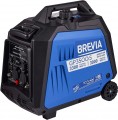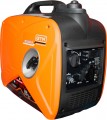Rated power
The nominal power of a generator is the highest power that the unit can supply without problems for an unlimited period of time. In the “weakest” models, this figure is
< 1 kW, in the most powerful ones –
50–100 kW and even
more ; and generators with welding capabilities (see below) usually have a nominal power from
1–2 kW to
8–10 kW.
The main rule of choice in this case is as follows: the nominal power must not be lower than the total power consumption of the entire connected load. Otherwise, the generator will simply not be able to produce enough energy, or will work with overloads. However, to determine the minimum required generator power, it is not enough to simply add up the number of watts indicated in the characteristics of each connected device - the calculation method is somewhat more complicated. Firstly, it should be taken into account that only the active power of various equipment is usually indicated in watts; in addition, many AC electrical appliances consume reactive power ("useless" power consumed by coils and capacitors when working with such power). And the actual load on the generator depends on the total power (active plus reactive), indicated in volt-amperes. There are special coefficients and formulas for its calculation.
The second nuance is related to the power su
...pply of devices in which the starting power (and, accordingly, the power consumption at the moment of switching on) is significantly higher than the nominal one - these are mainly devices with electric motors such as vacuum cleaners, refrigerators, air conditioners, power tools, etc. You can determine the starting power by multiplying the standard power by the so-called starting coefficient. For equipment of the same type, it is more or less the same - for example, 1.2 - 1.3 for most power tools, 2 for a microwave oven, 3.5 for an air conditioner, etc.; more detailed data can be found in special sources. Starting load characteristics are necessary primarily to assess the required maximum generator power (see below) - however, this power is not always given in the characteristics, often the manufacturer indicates only the nominal power of the unit. In such cases, when calculating for equipment with a starting coefficient of more than 1, it is worth using the starting power, not the nominal power.
Also note that if there are several sockets, the specific division of the total power between them may be different. This point should be clarified separately - in particular, for specific types of sockets (for more details, see "230 V sockets", "400 V sockets").Max. power
The maximum power output that the generator can provide.
This power is slightly higher than the nominal (see above), but the maximum performance mode can only be maintained for a very short time - otherwise an overload occurs. Therefore, the practical meaning of this characteristic is mainly to describe the efficiency of the generator when working with increased starting currents.
Let us recall that some types of electrical appliances consume several times more power (and, accordingly, power) at the moment of starting than in the normal mode; this is typical mainly for devices with electric motors, such as power tools, refrigerators, etc. However, increased power for such equipment is needed only for a short time, normal operation is restored in literally a few seconds. And you can estimate the starting characteristics by multiplying the nominal power by the so-called starting coefficient. For equipment of the same type, it is more or less the same (1.2 - 1.3 for most power tools, 2 for a microwave oven, 3.5 for an air conditioner, etc.); more detailed data is available in special sources.
Ideally, the maximum power of the generator should be no less than the total peak power of the connected load - that is, the starting power of equipment with a starting factor greater than 1 plus the rated power of all other equipment. This will minimize the likelihood of overloads.
Alternator winding
—
Copper. Copper winding is typical for advanced class generators. The copper alternator is characterized by high conductivity and low resistance. The conductivity of copper is 1.7 times higher than the conductivity of aluminium, such a winding heats up less, and compounds made of this metal endure temperature drops and vibration loads. Among the disadvantages of the copper winding, one can only note the high cost of the alternator. Otherwise, generators with copper winding have high reliability and durability.
— Aluminium. The aluminium winding of the alternator is typical for low-cost-class generators. The main advantages of aluminium are light weight and low price; otherwise, such a winding is usually inferior to copper counterparts. An oxide film is created on the surface of aluminium, it appears everywhere, even in the places of contact soldering. The oxide film undermines the contacts and does not allow the outer protective braid to securely hold the aluminium conductors.
Motor type
Model name of the engine installed in the generator. Knowing this name, you can, if necessary, find detailed data on the engine and clarify how it meets your requirements. In addition, model data may be needed for some specific tasks, including maintenance and repair.
Note that modern generators are often equipped with
branded engines from famous manufacturers: Honda, John Deere, Mitsubishi, Volvo, etc. Such engines are more expensive than similar units from little-known brands, but this is offset by higher quality and/or solid warranty conditions , and in many cases, the ease of finding spare parts and additional documentation (such as manuals for special maintenance and minor repairs).
Engine size
The working volume of the engine in a gasoline or diesel generator (see "Fuel"). Theoretically, more volume usually means more power, but in fact, everything is not so clear. Firstly, the specific power strongly depends on the type of fuel, and in gasoline units, also on the type of internal combustion engine (see above). Secondly, similar engines of the same power can have different volumes, and there is a practical point here: with the same power, a larger engine consumes more fuel, but by itself it can cost less.
Fuel tank volume
The volume of the fuel tank installed in the generator.
Knowing the fuel consumption (see above) and the capacity of the tank, you can calculate the operating time on one gas station (if it is not indicated in the specifications). However, a more capacious tank is also more bulky. Therefore, manufacturers choose tanks based on the general level and "voracity" of the generator — in order to provide an acceptable operating time without a significant increase in size and weight. So in general, this parameter is more of a reference than practically significant.
As for the numbers, in low-power models, tanks are installed for
5 – 10 liters, or even
less ; in heavy professional equipment, this figure can
exceed 50 liters.
Total number of sockets
The total number of sockets for 230 and/or 400 V provided in the design of the generator.
This number corresponds to the number of devices that can be simultaneously connected to the generator without using splitters, extension cords, etc. If it is a three-phase model (see "Output voltage") with different types of sockets, it is worth specifying the quantity of each type separately, as different models may have varying configurations. For example, a unit specified as having
3 sockets might have 1 three-phase socket and 2 single-phase ones, or 2 three-phase and 1 single-phase socket. Generally, the most basic modern generators have only
1 socket, though models with
2 sockets are more common; and the most powerful models can have
4 or more sockets.
It is also important to remember that the ability to connect various devices is limited not only by the number of sockets but also by the generator's rated power (see above for more details).
Sockets 230 V
The number of 230 V sockets provided in the design of the generator, as well as the type of connectors used in such sockets.
The type of connector in this case is indicated by the maximum power that is allowed for the outlet - for example, “2 pieces for 16 A”. The most popular options for 230-volt outlets are
16 A,
32 A, and 63 A. We emphasize that amperes in this designation are not the actual power that the generator can produce, but the outlet’s own limitation; the actual power value is usually noticeably lower. Simply put, if, for example, the generator has a 32 A socket, the output power on it will not reach 32 A; and the specific number of amperes will depend on the rated and maximum power of the unit (see above). So, if for our example we take a rated power of 5 kW and a maximum of 6 kW, then to a 230 V outlet such a generator will be able to produce no more than 5 kW / 230 V = 22.7 A standard and 6 kW / 230 V = 27, 3 A at its peak. And if the power has to be divided between several outlets, then it will accordingly be even less.
As for specific types of connectors, the higher the power permissible for the outlet, the higher the requirements for its reliability and quality of protection. In light of this, as a rule, higher power outlets can be connected to lower power plugs (directly or through an adapter), but not vice versa. And if there are several sockets, by their type it i
...s possible to estimate with some certainty the distribution of the entire power of the generator between them: between two identical sockets such power is usually divided equally, and more power is allocated to an socket with a larger number of amperes and power. However, specific details on this matter should be clarified separately in each case; It's also worth considering 400V outlets, if available (see below).Wheels
The electric generator has
wheels for moving from place to place. Most often, the design provides for a pair of wheels and a pair of parking supports: during working hours, the supports play the role of brakes, and when moving, they need to be raised above the ground and the generator rolled on two wheels; however, there are models on 4 wheels. Anyway, this feature greatly simplifies transportation: it is much easier to roll the unit than to carry it on weight. This is especially true in light of the fact that the weight of a modern generator can exceed 100 kg: several people will be needed to carry such a weight, while wheels often make it possible to manage by one person.

